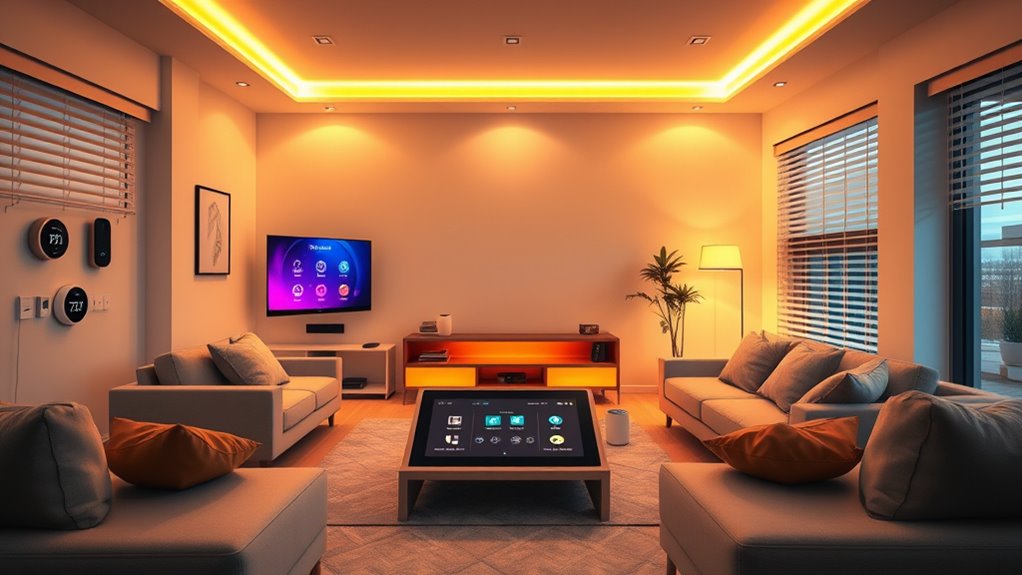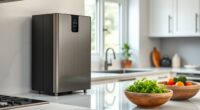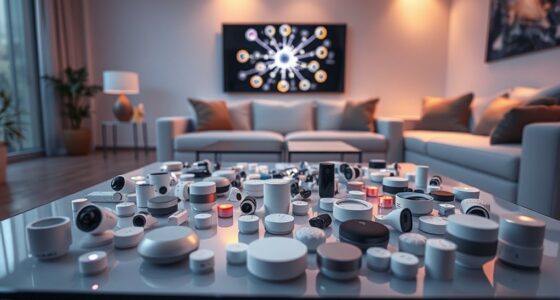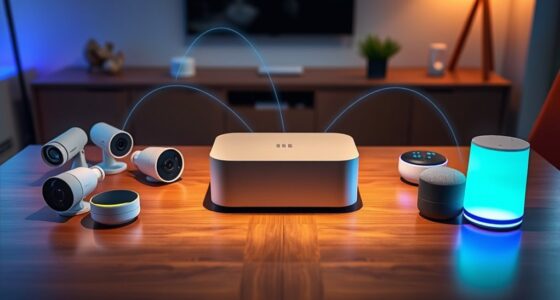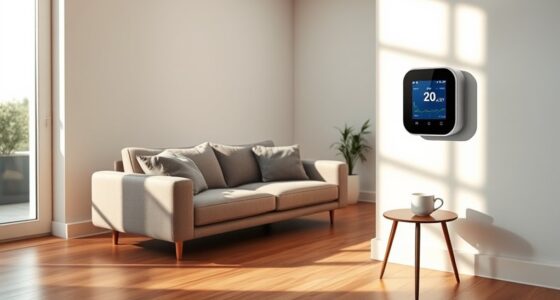A beginner’s guide to home automation routines involves starting with a few smart devices, like lights or locks, and learning how to control them with voice commands or smartphone apps. You can set routines to turn on lights at sunset, lock doors at night, or adjust the thermostat automatically. As you become comfortable, you can expand your system to include more devices and create customized routines, making your home more comfortable, efficient, and responsive. Keep exploring to discover even smarter ways to automate your space.
Key Takeaways
- Start small by automating basic devices like lights and gradually add more for a personalized smart home.
- Use voice assistants to create simple routines, such as turning off lights or locking doors with voice commands.
- Schedule routines based on daily habits to enhance convenience and energy efficiency.
- Customize routines to include multiple devices, like dimming lights and closing blinds at bedtime.
- Expand your system over time by integrating additional smart devices and refining your routines for better automation.

Have you ever wished your home could anticipate your needs and simplify your daily routines? With home automation, that’s entirely possible. One of the easiest ways to start is by integrating smart lighting and voice control into your space. Imagine walking into a room, and your lights automatically turn on at your preferred brightness without lifting a finger. Or, picture waking up and simply saying, “Good morning,” to have your lights gradually brighten, your blinds open, and your favorite morning playlist start playing. These simple actions can transform your home into an intuitive, responsive environment.
Imagine a home that responds to your needs with smart lighting and voice commands.
Smart lighting is a game changer for beginners. It’s straightforward to install and offers immediate benefits. You can replace your traditional bulbs with smart LEDs, which connect to your Wi-Fi network. Once set up, you’ll have control over your lighting from your smartphone or voice assistant. Want to create a cozy movie night atmosphere? Just say, “Dim the living room lights,” and watch them adjust instantly. Or, schedule your lights to turn off automatically at bedtime, saving energy and adding convenience. The key is setting up routines that fit your daily schedule. For example, program your lights to turn on gradually in the morning, mimicking sunrise and helping you wake up gently. These routines can be customized to match your lifestyle, making your home more comfortable and energy-efficient.
Voice control is the backbone of many home automation routines. It allows you to manage your smart devices hands-free, making everyday tasks easier. By connecting your smart lighting system to a voice assistant like Alexa, Google Assistant, or Siri, you can give simple commands to control the ambiance of your home. This means you don’t need to get up to find the switch or open an app; you just speak, and your home responds. Combining voice control with smart lighting lets you create personalized routines. For instance, you can say, “Good night,” and have your lights turn off, your doors lock, and your security system activate—all with a single voice command. Setting up these routines requires a bit of initial configuration, but once established, they run seamlessly in the background.
Getting started with home automation routines doesn’t have to be complicated. Focus on one or two smart devices at first—like smart lighting and voice control—and learn how they work together. Over time, you can expand your system, adding more devices and creating more sophisticated routines. The goal is to make your home more responsive, energy-efficient, and tuned to your needs. With just a little effort, you’ll find that your home becomes smarter, more convenient, and truly personalized to your lifestyle. Additionally, understanding the contrast ratio of your devices can help ensure your home entertainment setup delivers optimal image quality.
Frequently Asked Questions
Can I Automate Multiple Brands of Smart Devices Simultaneously?
Yes, you can automate multiple brands of smart devices simultaneously. Many smart home platforms support multi brand compatibility, allowing you to create routines that synchronize devices from different manufacturers. This means you can set up routines that trigger various devices together, regardless of brand, making your smart home more integrated and convenient. Just make certain your chosen platform or hub supports routine synchronization across the brands you want to connect.
How Secure Are Home Automation Routines From Hacking?
You might wonder how secure your home automation routines are from hacking. While they offer convenience, privacy concerns and hacking vulnerabilities exist. To protect yourself, use strong, unique passwords, enable two-factor authentication, and keep your devices’ firmware updated. Avoid connecting devices to unsecured networks, and consider setting up a separate network for smart devices. These steps help minimize risks and enhance your routine’s security against potential hacking threats.
Do Routines Work During Power Outages or Internet Disruptions?
Imagine a quiet moment when your routines face a gentle pause. During a power outage or internet disruption, many home automation routines may temporarily halt or behave unpredictably. Some smart devices rely on constant power and internet connectivity, so they might not respond as usual. To keep things running smoothly, consider backup options like uninterruptible power supplies or local control hubs, ensuring your home stays comfortable even when disruptions occur.
Can I Customize Routines for Individual Family Members?
Yes, you can customize routines for individual family members by creating personalized schedules that reflect their preferences. Many home automation systems allow you to set specific triggers and actions tailored to each person, such as adjusting lighting, temperature, or media. This way, everyone enjoys a seamless experience aligned with their routines. With a little setup, you guarantee each family member’s preferences are prioritized, making your smart home truly personalized.
What Is the Cost Range to Set up Basic Automation Routines?
Thinking about automation costs is like weighing your options before a big purchase. For basic routines, you can expect to spend between $50 and $300, depending on your smart home budget. You might need a smart hub, some smart bulbs, or plugs, but the costs stay manageable. Keep in mind, investing wisely now pays off later, making your home smarter without breaking the bank.
Conclusion
Now, with your home automation routines set, your space becomes a seamlessly flowing sanctuary—lights dim, coffee brews, and doors lock themselves as you unwind. Imagine a morning where your home gently awakens with you, and an evening where everything quietly settles into comfort. It’s a balance of technology and tranquility, transforming your house into a smart haven. Embrace these routines, and watch your everyday life become effortlessly smoother and more connected.
